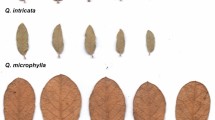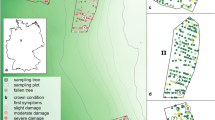Abstract
Key message
Clonal delineation at nuclear microsatellites and phenotypic traits showed high correspondence and revealed an important role of both sexual and clonal reproduction for stand genetic structure.
Abstract
Quaking aspen (Populus tremuloides Michx.) grows throughout the northern and central portions of North America. Reproduction occurs both sexually via seeds and clonally from root suckers. Clonal delineation using morphological/phenological traits, and more recently, highly variable nuclear microsatellites have shown considerable variation in the size of clonal assemblies, and the relative importance of sexual versus clonal reproduction across the species range. In order to provide reliable estimates of genet size (N/G; ramets per sampled genet) and genotypic diversity (G/N; genets/ramets), and to compare genetic and phenotypic clone delineation, we characterized 181 sampled stems (ramets) at seven nuclear microsatellites, and morphological and phenological traits from six clones (genet size ≥11). Genotypic diversity was moderate (G/N = 0.18) and within the range reported in other studies across North America. Multivariate statistics revealed a high correspondence between genetic and phenotypic clone delineation, both with and without predefined genetic groups (94.2 %, 81.7 %). Moderate average genet size (5.6 ramets per genet) and the occurrence of genetically distinct single-ramet genets surrounded by larger genets suggested intermediate levels of sexual reproduction contributing to the genetic structure of this stand. Significant differences among genets were found for phenological and morphological traits such as bark thickness and leaf shape. However, most clones showed no significant differences in diameter growth which was likely caused by poor drainage in this high clay soil that inhibited the expression of genetic differences in growth.



Similar content being viewed by others
References
Barnes BV (1959) Natural variation and clonal development of Populus tremuloides and Populus grandidentata in northern Lower Michigan. University of Michigan, Ann Arbor
Barnes BV (1966) The clonal growth habit of American aspens. Ecology 47:439–447
Barnes BV (1969) Natural variation and delineation of clones of Populus tremuloides and P. grandidentata in northern Lower Michigan. Silvae Genet 18:130–142
Barnes BV, Han FQ (1993) Phenotypic variation of chinese aspens and their relationships to similar taxa in Europe and North-America. Can J Bot Rev Can Bot 71:799–815
Bergsma W (2012) A bias-correction for Cramér’s V and Tschuprow’s T. J Korean Stat Soc 42:323–328
Bradshaw H, Stettler R (1995) Molecular genetics of growth and development in Populus. IV. Mapping QTLs with large effects on growth, form, and phenology traits in a forest tree. Genetics 139:963–973
Cheliak WM (1993) Clone identification. In: Ahuja MR, Libby WJ (eds) Clonal forestry I. Genetics and biotechnology. Springer, Berlin, pp 101–109
Cheliak W, Pitel J (1984) Electrophoretic identification of clones in trembling aspen. Can J For Res 14:740–743
Clinch JJ, Keselman HJ (1982) Parametric alternatives to the analysis of variance. J Educ Stat 7:207–214
De Woody J, Rowe CA, Hipkins VD, Mock KE (2008) “Pando” lives: molecular genetic evidence of a giant aspen clone in Central Utah. West N Am Nat 68:493–497
De Woody J, Rickman TH, Jones BE, Hipkins VD (2009) Allozyme and microsatellite data reveal small clone size and high genetic diversity in aspen in the southern Cascade Mountains. For Ecol Manag 258:687–696
Ellstrand NC, Roose ML (1987) Patterns of genotypic diversity in clonal plant species. Am J Bot 74:123–131
Eriksson G, Ekberg I, Clapham D (2006) An introduction to forest genetics. SLU, Swedish University of Agricultural Sciences, Uppsala
Estoup A, Jarne P, Cornuet JM (2002) Homoplasy and mutation model at microsatellite loci and their consequences for population genetics analysis. Mol Ecol 11:1591–1604
Fabbrini F, Gaudet M, Bastien C, Zaina G, Harfouche A, Beritognolo I, Marron N, Morgante M, Scarascia-Mugnozza G, Sabatti M (2012) Phenotypic plasticity, QTL mapping and genomic characterization of bud set in black poplar. BMC Plant Biol 12:47
Famy T, Aubry P (2013) XLSTAT-Pro (version 2013.5.06). Society of Addinsoft 20
Frewen BE, Chen THH, Howe GT, Davis J, Rohde A, Boerjan W, Bradshaw HD (2000) Quantitative trait loci and candidate gene mapping of bud set and bud flush in Populus. Genetics 154:837–845
Gom LA, Rood SB (1999) The discrimination of cottonwood clones in a mature grove along the Oldman River in southern Alberta. Can J Bot Rev Can Bot 77:1084–1094
Hill T, Lewicki P (2006) Statistics: methods and applications: a comprehensive reference for science, industry, and data mining. StatSoft Inc, Tulsa
IBM (2013) IBM SPSS Statistics for Windows IBM Corp., Armonk, NY
Jelínková H, Tremblay F, DesRochers A (2009) Molecular and dendrochronological analysis of natural root grafting in Populus tremuloides (Salicaceae). Am J Bot 96:1500–1505
Jelínková H, Tremblay F, DesRochers A (2014) The use of digital morphometrics and spring phenology for clone recognition in trembling aspen (Populus tremuloides Michx.) and its comparison to microsatellite markers. Trees Struct Funct 28:389–398
Kanaga MK, Ryel RJ, Mock KE, Pfrender ME (2008) Quantitative-genetic variation in morphological and physiological traits within a quaking aspen (Populus tremuloides) population. Can J For Res Rev Can Rech For 38:1690–1694
Kemperman JA, Barnes BV (1976) Clone size in American aspens. Can J Bot-Rev Can Bot 54:2603–2607
Kurth VJ, D’Amato AW, Palik BJ, Bradford JB (2014) Fifteen-year patterns of soil carbon and nitrogen following biomass harvesting. Soil Sci Soc Am J 78:624–633
Latutrie M, Mérian P, Picq S, Bergeron Y, Tremblay F (2015) The effects of genetic diversity, climate and defoliation events on trembling aspen growth performance across Canada. Tree Genet Genomes 11:1–14
McCune B, Grace JB (2002) Analysis of ecological communities. MjM Software Design, Gleneden Beach
McDonough WT (1985) Sexual reproduction, seeds and seedlings. In: DeByle NV, Winokus RP (eds) Aspen: ecology and management in the western United States. US Forest Service, Fort Collins
Mock KE, Rowe CA, Hooten MB, Dewoody J, Hipkins VD (2008) Clonal dynamics in western North American aspen (Populus tremuloides). Mol Ecol 17:4827–4844
Mooi EA, Sarstedt M (2011) A concise guide to market research: the process, data, and methods using IBM SPSS statistics. Springer, Berlin
Namroud MC, Park A, Tremblay F, Bergeron Y (2005) Clonal and spatial genetic structures of aspen (Populus tremuloides Michx.). Mol Ecol 14:2969–2980
O’Brien RM (2007) A caution regarding rules of thumb for variance inflation factors. Qual Quant 41:673–690
Paetkau D, Strobeck C (1994) Microsatellite analysis of genetic variation in black bear populations. Mol Ecol 3:489–495
Parks JC, Werth CR (1993) A study of spatial features of clones in a population of bracken fern, Pteridium aquilinum (Dennstaedtiaceae). Am J Bot 80:537–544
Peakall R, Smouse PE (2006) GENEALEX 6: genetic analysis in Excel. Population genetic software for teaching and research. Mol Ecol Notes 6:288–295
Perala DA (1990) Populus tremuloides Michx. In: Burns RM, Honkala BH (eds) Silvics of North America, vol 2., USDA Forest ServiceWashington, D.C., pp 555–569
Ponder F, Fleming RL, Berch S, Busse MD, Elioff JD, Hazlett PW, Kabzems RD, Kranabetter JM, Morris DM, Page-Dumroese D, Palik BJ, Powers RF, Sanchez FG, Scott DA, Stagg RH, Stone DM, Young DH, Zhang JW, Ludovici KH, McKenney DW, Mossa DS, Sanborn PT, Voldseth RA (2012) Effects of organic matter removal, soil compaction and vegetation control on 10th year biomass and foliar nutrition: LTSP continent-wide comparisons. For Ecol Manag 278:35–54
Romme WH, Turner MG, Tuskan GA, Reed RA (2005) Establishment, persistence, and growth of aspen (Populus tremuloides) seedlings in Yellowstone National Park. Ecology 86:404–418
Smulders MJM, Van Der Schoot J, Arens P, Vosman B (2001) Trinucleotide repeat microsatellite markers for black poplar (Populus nigra L.). Mol Ecol Notes 1:188–190
St Clair SB, Mock KE, LaMalfa EM, Campbell RB, Ryel RJ (2010) Genetic contributions to phenotypic variation in physiology, growth, and vigor of western Aspen (Populus tremuloides) clones. For Sci 56:222–230
Sydes MA, Peakall R (1998) Extensive clonality in the endangered shrub Haloragodendron lucasii (Haloragaceae) revealed by allozymes and RAPDs. Mol Ecol 7:87–93
Taberlet P, Luikart G (1999) Non-invasive genetic sampling and individual identification. Biol J Linn Soc 68:41–55
Tamhane AC (1977) Multiple comparisons in model-I one-way ANOVA with unequal variances. Commun Stat Theory Methods 6:15–32
Tuskan GA, Francis KE, Russ SL, Romme WH, Turner MG (1996) RAPD markers reveal diversity within and among clonal and seedling stands of aspen in Yellowstone National Park, USA. Can J For Res Rev Can Rech For 26:2088–2098
van der Schoot J, Pospísková M, Vosman B, Smulders MJM (2000) Development and characterization of microsatellite markers in black poplar (Populus nigra L.). Theor Appl Genet 101:317–322
Voldseth R, Palik B, Elioff J (2011) Ten-year results from the long-term soil productivity study in aspen ecosystems of the northern Great Lakes region. Research Paper NRS-17. United States Department of Agriculture (USDA), Forest Service, Newton square, Panewtown square, PA
Wyman J, Bruneau A, Tremblay M-F (2003) Microsatellite analysis of genetic diversity in four populations of Populus tremuloides in Quebec. Can J Bot-Rev Can Bot 81:360–367
Yoo W, Mayberry R, Bae S, Singh K, He Q, Lillard JW (2014) A study of effects of multicollinearity in the multivariable analysis. Int J Appl Sci Technol 4:9–19
Acknowledgments
Funding for the study was provided by the US Forest Service Northern Research Station. Additional funding was made available by the Ecosystem Science Center and the Biotech Research Center of Michigan Technological University. We would like to thank Ted Maynard, Joseph Langley and Bryan Reitter for their help with field work and data collection. We are also thankful to Evan Kane and Janice Glime for their advice and valuable discussions during the project.
Author information
Authors and Affiliations
Corresponding author
Ethics declarations
Conflict of interest
The authors declare that they have no conflict of interest.
Additional information
Communicated by R. Alia.
Electronic supplementary material
Below is the link to the electronic supplementary material.
Rights and permissions
About this article
Cite this article
Flesher, K.N., Jurgensen, M.F. & Gailing, O. Comparison of phenotypic and genetic clone delineation in quaking aspen, Populus tremuloides . Trees 30, 1657–1667 (2016). https://doi.org/10.1007/s00468-016-1398-1
Received:
Accepted:
Published:
Issue Date:
DOI: https://doi.org/10.1007/s00468-016-1398-1




